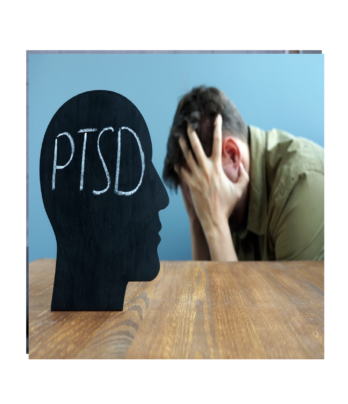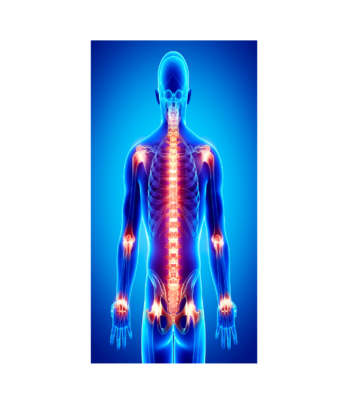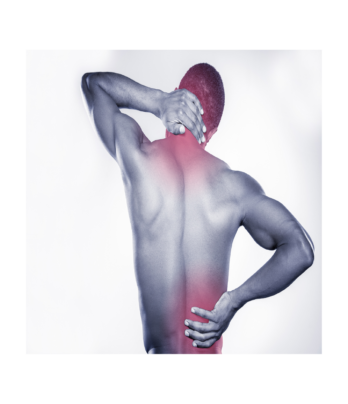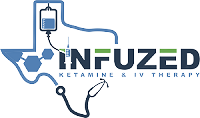Ketamine Therapy
Ketamine has been shown to help with:

Anxiety
Anxiety disorders encompass various types, including generalized anxiety disorder (GAD), social anxiety disorder, panic disorder, specific phobias, and more. The severity and specific symptoms may vary depending on the type of anxiety disorder a person experiences. Over 40 million adults in the US suffer from anxiety. Unfortunately, only around a third will receive treatment.
It's essential to recognize that anxiety disorders are treatable, and there are various effective therapies and interventions available, such as cognitive-behavioral therapy (CBT), medication, mindfulness techniques, and lifestyle changes. There is no single treatment that is right for everyone.

Depression
Depression is a mental health or mood disorder characterized by persistent feelings of sadness, emptiness, and a lack of interest or pleasure in activities that were once enjoyable. It goes beyond the normal fluctuations in mood that everyone experiences and can significantly impact a person's thoughts, feelings, behavior, and overall well-being.
Symptoms of depression can vary from person to person, but some common signs include:
- Persistent sadness or a feeling of emptiness
- Loss of interest or pleasure in most activities
- Changes in appetite or weight (either increased or decreased)
- Insomnia or excessive sleeping
- Fatigue or loss of energy
- Feelings of worthlessness or excessive guilt
- Difficulty concentrating or making decisions
- Recurring thoughts of death or suicide
Depression is a serious condition and can affect anyone regardless of age, gender, or background. It is essential to note that depression is not a sign of weakness. Nor s it something that a person can simply "snap out of." It is a complex condition that often requires professional help to treat effectively There are various factors that can contribute to the development of depression, such as genetics, brain chemistry, personality traits, life events, and other medical conditions.

Obsessive Compulsive Disorder
Obsessive Compulsive Disorder is a mental health disorder characterized by recurring and intrusive thoughts (obsessions) and repetitive behaviors (compulsions). People with OCD often experience distressing and unwanted thoughts, images, or urges, which lead to significant anxiety. To cope with this anxiety, they engage in repetitive rituals or behaviors.
Here's a breakdown of the two main components of OCD:
- Obsessions: These are unwanted, intrusive, and distressing thoughts, urges, or mental images that individuals with OCD experience. Obsessions may revolve around themes. Theses can include contamination, fear of harm to self or others, unwanted sexual thoughts, religious or moral concerns, and a need for symmetry or exactness. These obsessions can be persistent and cause significant distress and disruption in daily life.
- Compulsions: These are repetitive behaviors or mental acts that individuals with OCD perform. They are in response to their obsessions. Compulsions are aimed at reducing the anxiety caused by the obsessive thoughts. Although, they are often excessive and not connected to any realistic danger. Common compulsions include hand washing, checking, counting, repeating actions, mental reviewing, or praying.
People with OCD know that their obsessions and compulsions are irrational. However, these individuals find it challenging to resist performing these behaviors. The cycle of obsessions leading to anxiety and compulsions temporarily relieving that anxiety can become a distressing loop. It has significant impacts on their personal and professional life.
Obsessive Compulsive Disorder can vary in severity, and its onset can be in childhood, adolescence, or adulthood. Treatments for OCD may include cognitive-behavioral therapy (CBT), exposure and response prevention (ERP), and in some cases, medication. Early intervention and proper management can significantly improve the quality of life for individuals living with OCD.

Addiction
Addiction refers to a complex and chronic psychological and physical condition characterized by the compulsive and uncontrollable consumption of substances or engagement in behaviors despite negative consequences. It is often considered a brain disorder. It involves a combination of biological, genetic, environmental, and psychological factors.
Substances that commonly lead to addiction include drugs (both legal and illegal), alcohol, and nicotine. Behaviors that can lead to addiction include gambling, internet use, gaming, and even certain types of activities or behaviors that release dopamine. Dopamine is a neurotransmitter associated with pleasure and reward.
Key characteristics of addiction include:
- Compulsion: People with addiction often feel a strong urge or compulsion to engage in the addictive behavior or consume the substance, even when they are aware of the negative consequences.
- Loss of Control: Individuals find it difficult to control their consumption of the substance or engagement in the behavior. This can lead to excessive use or involvement.
- Negative Consequences: Despite being aware of the harmful consequences, addicted individuals continue to engage in the behavior or consume the substance. These consequences can affect various areas of life. This includes health, relationships, work, and finances.
- Tolerance: Over time, the body and brain can develop tolerance to the substance or behavior. Hence, it requires higher amounts or increased intensity to achieve the desired effect.
- Withdrawal: When the substance or behavior is suddenly stopped, individuals can experience withdrawal symptoms. These symptoms can range from mild discomfort to severe physical and psychological effects.
- Distorted Thinking: Addiction often leads to distorted thinking patterns. Addicted individuals rationalize their behavior, deny the extent of their problem, or engage in self-deception.
- Interference with Daily Life: Addiction can disrupt a person's ability to fulfill responsibilities at work, school, or home. And can lead to a decreased quality of life overall.

Post Traumatic Stress Disorder
Post-Traumatic Stress Disorder is a mood disorder that can develop in some individuals after experiencing or witnessing a traumatic event. It is estimated that one out of 11 people will be diagnosed with PTSD in their lifetime. The condition can occur after various distressing events. These include military combat, sexual assault, natural disasters, serious accidents, or other life-threatening situations.
Symptoms of PTSD can be grouped into four main categories:
- Intrusive Memories: Individuals may experience distressing and recurrent memories of the traumatic event, flashbacks, nightmares, or intense emotional or physical reactions when reminded of the event.
- Avoidance: People with PTSD may try to avoid thoughts, feelings, or situations that remind them of the trauma. They may withdraw from friends and family. They may also avoid talking about the event or steer clear of certain places or activities that trigger distressing memories.
- Negative Changes in Thinking and Mood: This includes experiencing negative emotions, feelings of detachment or estrangement from others. It may also include difficulty experiencing positive emotions, memory problems related to the trauma, and negative beliefs about oneself or the world.
- Changes in Arousal and Reactivity: Individuals with PTSD may become easily startled, experience difficulty sleeping, have outbursts of anger, or have trouble concentrating. They may also exhibit hypervigilance or be constantly on guard for potential threats.

Chronic Migraines
Migraines are a type of severe headache that can cause intense throbbing or pulsating pain, often on one side of the head. They are a neurological condition and can be debilitating for those who experience them. Migraines are more than just headaches. They usually come with other symptoms and can significantly impact daily life.
Key characteristics of migraines include:
- Throbbing Pain: The headache typically presents as a throbbing or pulsating pain. This pain can worsen with physical activity or exposure to light and sound.
- Unilateral: Migraines often affect one side of the head, though they can sometimes occur on both sides.
- Duration: Migraine attacks can last for a few hours to several days. The frequency of these attacks varies from person to person.
- Other Symptoms: Migraines may come with other symptoms, such as nausea, vomiting, sensitivity to light and sound (photophobia and phonophobia), and visual disturbances known as auras. Not everyone with migraines experiences auras.
- Triggers: Migraines can be triggered by various factors. These include certain foods, hormonal changes, stress, lack of sleep, bright lights, strong smells, and environmental changes.
- Phases: Migraine attacks often have distinct phases. The prodrome phase (pre-headache warning signs like mood changes or food cravings), the aura phase (visual or sensory disturbances for some individuals), the headache phase, and the postdrome phase (recovery period).
- Family History: Migraines tend to run in families, indicating a genetic predisposition.

Fibromyalgia
Fibromyalgia is a chronic medical condition characterized by widespread pain and tenderness in the muscles, ligaments, and tendons. It is considered a complex disorder, and its exact cause is not fully understood. The condition is more common in women than men. It typically starts between the ages of 30 and 60, although it can occur at any age.
Key features of fibromyalgia include:
- Widespread Pain: The hallmark symptom is widespread, chronic pain that affects various parts of the body. The pain can be described as a constant dull ache, often accompanied by a sensation of stiffness.
- Tender Points: People with fibromyalgia often have specific tender points on their body. These tender points are specific locations that are more sensitive to pressure than surrounding areas.
- Fatigue: Fatigue and lack of energy are common complaints among individuals with fibromyalgia. Even after a full night's sleep, they may wake up feeling tired and unrefreshed.
- Sleep Disturbances: Sleep disturbances are common in fibromyalgia, including difficulty falling asleep, waking up frequently during the night, and waking up feeling tired.
- Cognitive Issues: Many people with fibromyalgia experience cognitive difficulties often referred to as "fibro fog." This can involve problems with memory, concentration, and focus.
- Other Symptoms: Other symptoms that may occur in fibromyalgia include headaches, irritable bowel syndrome (IBS), temporomandibular joint disorder (TMJ), sensitivity to noise, light, and temperature changes.
The diagnosis of fibromyalgia is based on a clinical evaluation by a healthcare professional, taking into account the patient's medical history, symptoms, and a physical examination. There is no specific test or imaging study to confirm the diagnosis, which can make it challenging to diagnose.

Neuropathic Pain
Neuropathic pain, also known as peripheral neuropathy, neuralgia or nerve pain, is a condition that involves damage or dysfunction of the peripheral nerves. These nerves are responsible for transmitting signals between the central nervous system (the brain and spinal cord) and the rest of the body, including the limbs, organs, and skin. Neuropathy can manifest in various ways. And, it can affect different types of nerves, leading to a wide range of symptoms. Common symptoms of neuropathy include:
- Tingling and numbness: Individuals with neuropathy often experience a sensation of pins and needles. It can also cause numbness in the affected areas.
- Burning or shooting pain: Many people with neuropathy describe feeling a burning pain, electric shock-like sensations, or shooting pains. These pains can be intermittent or constant.
- Muscle weakness: Neuropathy can lead to muscle weakness, making it difficult to perform everyday tasks or maintain balance.
- Sensitivity to touch: Some individuals may become hypersensitive to touch or experience pain when even a light touch is applied to the affected areas.
- Loss of coordination: Neuropathy can affect motor skills and coordination. Hence, it can lead to difficulties in walking and performing fine movements.
- Autonomic dysfunction: In certain cases, neuropathy can also affect the autonomic nervous system. This can lead to problems with blood pressure regulation, heart rate, digestion, and other involuntary bodily functions.

Chronic Regional Pain Syndrome
Complex Regional Pain Syndrome (CRPS) is a chronic and often debilitating condition. It is characterized by severe and prolonged pain that affects a specific region of the body, typically an arm or a leg. CRPS is also sometimes referred to as Reflex Sympathetic Dystrophy (RSD).
The exact cause of Complex Regional Pain Syndrome is not fully understood. But, it often develops after an injury or trauma to the affected limb. The pain associated with CRPS is disproportionate to the severity of the initial injury. And, it can spread beyond the original site of injury. CRPS may also involve various other symptoms, such as:
- Intense burning or throbbing pain
- Swelling and changes in skin temperature and color (the affected limb may become red or blue)
- Sensitivity to touch or even light touch (allodynia)
- Changes in skin texture or sweating patterns
- Muscle weakness and stiffness
- Limited range of motion
Learn More About Ketamine Infusions
Ketamine is the first rapid-acting antidepressant and legal psychedelic that has been designated as breakthrough therapy by the FDA.

KETAMINE IS AN FDA APPROVED MEDICATION
Ketamine is an FDA approved medication that has been used for many decades as an anesthetic agent. It is considered to be an essential medication by the World Health Organization. This is due to its high degree of safety and efficacy. It is commonly used in a variety of situations. These range from treating wounded soldiers in the battlefield, complex cardiac surgeries and is often the top choice of anesthetic for children. FDA approval does not imply that there are no risks. But, rather that the benefits outweigh any potential risks. There is strong evidence to suggest that these infusions may provide relief of symptoms of certain chronic pain conditions, depression, anxiety, PTSD, OCD and other mood disorders. Ketamine’s use for these conditions is considered off-label because these aren’t the original indications that Ketamine was approved for. However, once a drug has been approved by the FDA for one purpose, healthcare providers may prescribe the drug for other purposes. Healthcare providers may deem it medically appropriate to be used for a different purpose. Appropriate off-label use of medication is ethical, legal and common. In fact, about 20% of all prescriptions written in the US today are considered off-label.
Ketamine has been in use for more than 50 years. Ketamine has the ability to go to work right away, unlike most antidepressants which can take weeks, sometimes months, to provide relief. Feeling better faster, getting the mood to improve faster can be lifesaving in someone with depression. When Ketamine is administered in a very controlled manner,
it triggers a sequence of events in the brain that regenerates damaged neurons.
While Ketamine therapy is proving to be very promising, a single treatment can’t be counted on to cure depression. Research has shown that a series of six infusions given every other day over a 12-14 day period can produce optimal outcomes. Ketamine infusion decreases the symptoms of depression in approximately 60-70 percent of all patients who receive it. It typically takes a minimum of three Ketamine infusions to determine if it will help you.
The majority of patients who respond to Ketamine therapy require “maintenance” infusions on an ongoing basis following the initial series of treatments. The frequency of these maintenance infusions varies from person-to-person and may be as often as one (1) to two (2) times per-month; while other patients may find their symptoms are manageable with little need for additional Ketamine.
During infusion, you will be awake and able to interact with those around you, listen to music or just close your eyes and relax. Some people experience dizziness, fuzzy vision or a sense of floating, but these symptoms clear up quickly after infusion stops. Some people report fatigue or grogginess after infusion, so you need to be accompanied by someone who can drive you home. Do not operate heavy equipment for at least 24 hours after the infusion.
No, it is very important that we review your current medication list prior to beginning Ketamine therapy. You will need to follow up with your psychiatrist or PCP after treatment, as your dosage may change.
Ketamine infusions are not currently covered by insurance. Payment must be received before scheduling infusion therapy.
Ketamine is an option for people with depression who are unable to get relief from other treatments. Studies have shown promising results about the drug’s impact on various mental health conditions, including anxiety, OCD, and substance-use disorders.
It’s important to note that ketamine can elevate the heart rate and blood pressure, so patients with pre-existing health conditions should speak with their doctors before seeking treatment. Ketamine is also not advisable for patients with certain psychiatric conditions.
We wish we could guarantee you’ll feel better after treatment, but there is no guarantee. Between 70-80% of clients see a greater than 50% reduction in their depression symptoms after 6 treatments. What we will know is during your first treatment if it’s going to work for you or not. You can expect mood improvement 3-4 hours after treatment. A series of treatments over 2-3 weeks is required for longer lasting effects. Side effects are minimal, and infusions take approximately 45-60 minutes.

